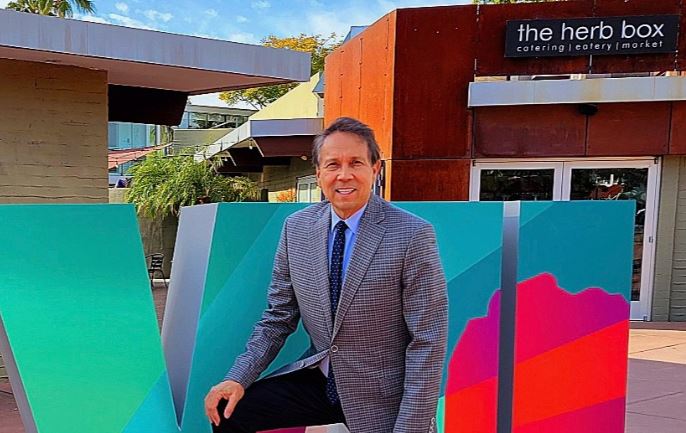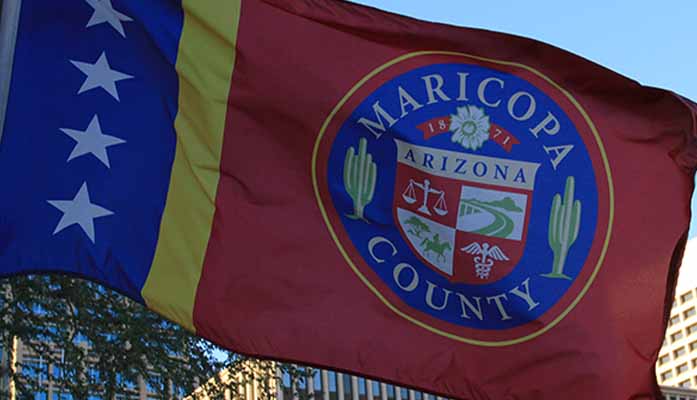
by Corinne Murdock | Jan 20, 2023 | News
By Corinne Murdock |
Scottsdale Mayor David Ortega has refused to allow Rio Verde citizens to use canal space to transport their water, effectively forcing them to go without, pay thousands in water bills, or leave their homes.
The Scottsdale canal route would be the short-term solution to save Rio Verde residents time and money until a proposed long-term solution, a stump pipe, can be worked out. In the meantime, Rio Verde residents must be frugal with what water they can obtain. Some have come to rely upon rainwater — a nonviable solution come summer. The trucks that reliably delivered affordable water for years are now expensive: per their 2021 drought plan, Scottsdale prohibited water haulers from taking water from its tanks, forcing truckers to trek through the Valley in search of water. Rio Verde residents face water bills of around $1,000.
During a House Natural Resources, Energy, & Water Committee meeting last week, Rio Verde’s representative, State Rep. Alex Kolodin (R-LD03), questioned Arizona Department of Water Resources (ADWR) Director Tom Buschatzke about Rio Verde residents’ predicament. Kolodin shared that EPCOR, a utility company, had offered to route water to the residents via a stump pipe, but in the meantime must transport it by truck.
Buschatzke said that, to his understanding, Scottsdale cut Rio Verdes’ water access off for preservation efforts. He said ADWR was willing to help as much as they could in obtaining groundwater for those residents via a stump pipe.
“[The city of Scottsdale] thought because of what’s happening on the river with those supplies, they needed to take that action to protect their customers and their own city,” said Buschatzke. “[Rio Verde residents] don’t have groundwater of their own to access, and that’s a big part of the problem.”
Kolodin asked why water purchased and transported from the Harquahala Valley wasn’t a viable idea. Buschatzke responded that EPCOR wasn’t eligible to use that water since they’re a private company, and because that water was considered a “non-groundwater source” under the law.
Kolodin told AZ Free News that EPCOR has had to undertake the costly endeavor of transporting the water by truck because the city of Scottsdale refused to allow access to their canal. Kolodin remarked that he doesn’t understand Ortega’s resistance to helping these communities, which he said was well within Ortega’s ability.
“I get why the city of Scottsdale doesn’t want to give them their water. I don’t understand why the city won’t let them transport other water through their canal until EPCOR can build the stump pipe,” said Kolodin. “I get it. You’re the mayor of Scottsdale, you want to circle the wagons. Why not let them move their water through your canal? That’s pure twisting their arm.”
Kolodin also questioned why Ortega wouldn’t opt to rent canal space for two years. He claimed that Ortega wasn’t happy that Rio Verde residents haven’t set up a water regulation structure yet continue to develop land, chalking it up to a “liberal agenda” of Ortega’s. Ortega was a longtime Democrat before becoming an independent.
“To me, that’s a sign of Mayor Ortega’s liberal agenda. He cares so much about forcing these people into groundwater regulation that he’s willing to hurt thousands of people just to teach them a lesson,” said Kolodin. “He wants to impose his liberal agenda on water regulation on them. He doesn’t like that they don’t live with a governmental structure. In his mind everyone should be regulated.”
Scottsdale has pushed its own citizens to reduce water usage due to the worsening drought over the past few years. The Bureau of Reclamation reclassified the Colorado River’s drought status worsened from Tier 1 last January to Tier 2a. While this would normally mean the city remains in Stage One of its Drought Management Plan issued 2021, the city warned residents that it was anticipating cuts from the federal government. In this first stage, the city issues recommendations and potentially restrictions, as well as shutting down or restricting commercial and residential fill stations.
Time is running out for these Rio Verde residents. In the meantime, Kolodin has busied himself arranging meetings between Rio Verde residents, EPCOR, Scottsdale City Council, the Arizona Corporation Commission, and even Freeport-McMoran for potential solutions.
Few others who speak publicly on the issue seem to empathize with the Rio Verde citizens’ plight. The Arizona State University (ASU) director of the Kyl Center for Water Policy, Sarah Porter, indicated to The New York Times that the homeowners bore some burden for their struggles since they bought an unincorporated area.
“It’s a cautionary tale for home buyers,” said Porter. “We can’t just protect every single person who buys a parcel and builds a home. There isn’t enough money or water.”
Corinne Murdock is a reporter for AZ Free News. Follow her latest on Twitter, or email tips to corinne@azfreenews.com.

by Corinne Murdock | Jan 19, 2023 | News
By Corinne Murdock |
On Monday, the Maricopa County Superior Court agreed that the city of Phoenix has failed to mitigate its burgeoning homeless crisis. In fact, the court declared that the city ending enforcement of criminal, health, and other statutes and ordinances concerning homelessness in 2019 worsened the crisis.
The court rejected Phoenix’s motion to dismiss in Brown v. Phoenix, citing 11 findings of fact proving that homelessness has only worsened under the city’s watch over the past four years. The court specifically cited the sprawling, growing homeless encampment in central Phoenix: “The Zone.”
“The situation inside the Zone has gotten progressively worse, not better, since 2019 and has become dire since November of 2021,” stated the court.
Phoenix Mayor Kate Gallego became the mayor in 2019.
The court specifically stated that The Zone has resulted in dramatic increases in violent crime, public drug use, break-ins, vandalisms, fires, trespassing, loitering, risk of violent crime, public urination and defecation, trash and human excrement in the streets and along business properties, prostitution, public nudity, lewd acts, tents and encampments blocking property and business access, and deaths of homeless.
Rather than attempting to work out a solution for the increasing homeless, the court said the city ignored plans to ease the burden of The Zone. Residents proposed outdoor camping shelter spaces on city lots to prevent public nuisance. However, the court stated that the city failed to act. The city confirmed during oral argument that it wasn’t considering that proposed solution because the lots wouldn’t come with air conditioning and heat for the homeless. The court rejected that rationale, noting that homeless residents of The Zone live without air conditioning and start bonfires to keep warm.
The lawsuit was brought forth by 19 plaintiffs last August: Phoenix business owners and property owners. Judge Alison Bachus is hearing the case.
One of those businesses is the Arizona Rock Products Association (ARPA), located near The Zone. According to ARPA, the homeless have wreaked havoc on their business: started fires, left used needles and condoms, defecated and urinated, broken into cars, trespassed, and stolen food from a refrigerator on ARPA property.
The lawsuit accuses the city of purposefully concentrating the homeless population into The Zone. The plaintiffs claimed that a “substantial portion” of these homeless were mentally ill, addicted to drugs, and constantly violating the city’s quality-of-life ordinances on loitering, disturbing the peace, drunk and disorderly conduct, drug use, domestic violence, and obstruction of public right-of-ways.
“In short, instead of seeking to solve the homelessness crisis, the City has effectively invited this population to construct semi-permanent tent dwellings on the public sidewalks and rights of way in Plaintiffs’ neighborhood, and to make the Zone their home,” stated the lawsuit. “The City has not only permitted this illegal conduct and maintained it on public lands within its control, but it has also encouraged it through a policy of directing other homeless persons from around the city to the Zone.”
The city’s homeless crisis has only worsened despite spending hundreds of millions in local, state, and federal funds over the last three years to solve the issue.
The city’s attempts to mitigate its growing homelessness problem preceded the pandemic. Weeks before a national emergency was declared nearly three years ago, Gallego was announcing plans on expanding the city’s shelter beds. The mayor told KJZZ that the city’s goal was to get those camping on the streets into shelters.
“I believe strongly that the best solutions are smaller facilities that are more distributed, where people can get more individual attention. But I understand that creating that network of facilities is going to take a long time,” said Gallego.
Throughout 2019, Gallego attempted to mitigate homelessness through billboard campaigns and repurposed parking meters to accept donations, dubbed “giving meters.”
Corinne Murdock is a reporter for AZ Free News. Follow her latest on Twitter, or email tips to corinne@azfreenews.com.

by Corinne Murdock | Jan 18, 2023 | News
By Corinne Murdock |
Maricopa County might become four counties, per a new resolution seeking to break up the fourth-largest county in the nation.
HCR2018 wants to shrink Maricopa County, then divide the remaining land into three counties named after Native American tribes that once populated the Valley and southern area of the state: Hohokam, Mogollon, and O’odham. The bill sponsor is State Rep. Alex Kolodin, cosponsored by State Reps. Joseph Chaplik, David Marshall, and Barbara Parker.
Kolodin told AZ Free News that the initiative is a continuation of a bill run last year; however, since this year’s version is a resolution it will ultimately be up to the voters to decide Maricopa County’s fate. Kolodin shared that voters discussed breaking up Maricopa County with him often on the campaign trail last year. The dissent to the proposal that he did hear concerned an increase in costs, but Kolodin said he thinks the opposite would be true.
“It’s never been my experience in government that having it smaller and more conservative increases costs,” said Kolodin. “There’s an optimal size for counties, and that’s not having a county board of supervisors that oversees over three-quarters of a million people. That’s more than a congressman.”
Kolodin noted that Maricopa County residents’ grievances with their current administration aren’t a shared experience by residents of other counties. In fact, he observed other counties having a positive relationship with their board of supervisors during his travels as a lawyer.
Kolodin argued that county officials should be able to pick up the phone and talk to constituents — a far-fetched concept for Maricopa County residents. The county has a population of about 4.5 million; Arizona has a population of around 7.4 million.
“Besides the problems of unaccountable government, people joke about the ‘great state of Maricopa.’ I think there’s lots of Democrats in Pima County that would agree that Maricopa County has an outsized presence. Counties should be relatively coequal entities,” observed Kolodin.
Kolodin said that the restructuring would also improve elections administration. Maricopa County experienced massive Election Day failures stemming from their printers.
“One thing we’ve learned from this last cycle is that Maricopa County is too big to effectively run itself anymore,” said Kolodin. “It completely screwed up the 2022 election. It’s too hard for them to run it.”
We also asked Kolodin to weigh in on community feedback regarding Maricopa County’s rebranding unveiled last week. Some noted that the new logo intended to depict an orange cactus looked like a middle finger.
“All I can say is these guys have spent the past several years demonstrating utter contempt for their constituents,” said Kolodin. “I’ve been involved in politics for a while, and the constant feeling is [that Maricopa County residents] don’t feel like they’re heard. You never hear that about the State House, ‘Oh these guys are so distant, they’re so inaccessible.’ You might disagree with us, but you would never feel that we don’t care about our constituents. People feel like members of the board of supervisors don’t care about their constituents, and they just feel like they’re not heard.”
Maricopa County has struggled to fulfill basic functions like public record requests or, most recently, complying in a timely manner with an Arizona Senate subpoena.
“They’re trying to run a state with a county’s infrastructure. It just doesn’t make any sense,” said Kolodin. “It gives rise to both arrogance and incompetence. The arrogance is they think they can thumb their nose at the state legislature. It upsets the constituents.”
Corinne Murdock is a reporter for AZ Free News. Follow her latest on Twitter, or email tips to corinne@azfreenews.com.

by Corinne Murdock | Jan 18, 2023 | Education, News
By Corinne Murdock |
House Democrats want taxpayers to fund the tuition of future K-12 school psychologists, social workers, and counselors.
State Rep. Judy Schwiebert proposed the arrangement in a bill establishing a K-12 mental health professionals academy in each of the state’s universities, HB2160. These universities would provide annual scholarships up to the actual cost of tuition and fees for up to three academic years or six semesters, as well as covering all costs of obtaining a school psychology, social work, or counseling certificate.
Even if these scholarships don’t cover all of the tuition and fee costs, the university would not be allowed to charge the student the remaining difference.
Funds to supply these scholarships would come from an “Arizona School Mental Health Professionals Academy Fund” established by the legislature. This fund would be continuously appropriated and exempt from lapsing. In addition to scholarships, this fund would pay for marketing and promotion plans in a yearly amount up to three percent of the fund, as well as unspecified “academy costs.”
Students in these proposed academies must work as a school psychologist, social worker, or counselor for one full year in an Arizona public school.
These academies would offer accelerated models for “critical need areas”: low-income public schools, Indian reservation public schools, rural public schools, and disability-oriented public schools.
The Arizona Board of Regents (ABOR) would be tasked with developing the academy, including marketing and promotion plans, data collection and tracking, overseeing post-graduation service requirements, and funds distribution. Every year before Sept. 1, ABOR would have to issue a report to the governor, state senate president, and state house speaker on academy data.
Schwiebert garnered 23 cosponsors for her bill.
Expanding the state’s reserves of K-12 mental health professionals was a priority for former Superintendent Kathy Hoffman. Hoffman reduced the disparity between students and counselors by nearly 300, from over 1,200 at the start of her administration to over 1,500 by the end — an increase of about 20 percent. In 2021, Hoffman allocated $21.3 million in federal and state funds to hire more K-12 mental health professionals.
During her campaign for re-election, Hoffman pledged to further balance the state’s student-to-counselor ratio.
The fixation on student mental health became more pronounced following the forced shutdowns of schools and businesses during the COVID-19 pandemic. Surgeon General Vivek Murthy warned in a December 2021 report that youth mental health declined greatly and rapidly over the course of the pandemic.
Since then, the Biden administration has spent hundreds of millions to address the issue. Most recently, they allocated $245.7 million last week: $73.6 million for school-based mental health programs and services; $57.7 million to train school personnel, emergency first responders, law enforcement, and others to recognize mental health issues for early intervention; $14.9 million for K-12 “trauma-informed” and “culturally relevant” support services and mental health care; $19.5 million for treatment of children, adolescents, and families that have experienced trauma; $20 million for the promotion of resilience and equity, as well as violence prevention in communities plagued with civil unrest, violence, and trauma; and $60 million for primary care clinician mental health training geared toward children and adolescents.
Corinne Murdock is a reporter for AZ Free News. Follow her latest on Twitter, or email tips to corinne@azfreenews.com.

by Corinne Murdock | Jan 18, 2023 | News
By Corinne Murdock |
Over half of the Arizona House Democrats are pushing to repeal the state’s ban on male athletes in K-12 female sports. The bill has yet to be assigned to a committee.
Freshman State Rep. Nancy Gutierrez (D-LD18) proposed the bill, HB2068. 14 Democrats signed on, including: State Reps. Flavio Bravo, Andrés Cano, Oscar De Los Santos, Melody Hernandez, Christopher Mathis, Analise Ortiz, Mariana Sandoval, Judy Schwiebert, Keith Seaman, Stephanie Stahl Hamilton, Laura Terech, and Stacey Travers. Democratic leadership also cosponsored the bill: Assistant Minority Leader Lupe Contreras and Minority Whip Marcelino Quiñonez.
Gutierrez, a Tucson High Magnet School yoga teacher, said that transgender athletes deserve to play on the team of their choosing. GLSEN Arizona, the state branch of the national organization pushing LGBTQ+ ideologies onto minors, endorsed the effort.
Gutierrez also opposes the state’s ban on gender transition procedures for minors, and the requirement for teachers to inform parents about their communication with students regarding sexuality or identity.
Planned Parenthood Advocates of Arizona (PPAZ), the political advocacy arm of Planned Parenthood Arizona, endorsed Gutierrez. Planned Parenthood Arizona offers hormone replacement therapy (HRT) on site and via telehealth. The effects of HRT may only last from six months to three years, meaning that patients must take it for life to experience its effects.
Last September, Planned Parenthood Arizona received a $10,000 grant from Phoenix Pride for their gender transition procedures, or “Gender Affirming Care” (GAC).
The Human Rights Campaign (HRC) also endorsed Gutierrez. HRC, an activist organization, denies that males have biological advantages to females.
The legislature banned males from female sports last year through SB1165. Democratic legislators spoke out in opposition to the bill, claiming that transgender athletes had no competitive edge over their non-transgendered peers. They also claimed that the bill solved a non-issue, since so few transgender athletes existed in the state.
Males who attempt to transition socially and/or physically as females retain their physical advantages to females, such as testosterone, muscle mass, height, and fat distribution. Even with a year of hormone treatments, they retain significant advantages.
However, activist organizations such as the ACLU dismiss those scientific findings as speculative.
There are 18 states that have banned students from participating in sports of the opposite sex. In addition to Arizona, these are Utah, Idaho, Montana, South Dakota, Iowa, Oklahoma, Texas, Arkansas, Louisiana, Missouri, Alabama, Tennessee, Kentucky, Indiana, West Virginia, South Carolina, and Florida.
While Democratic legislators are focused on affirming preferred identities, Republican legislators are focused on affirming biological realities and parental authority. State Sen. John Kavanaugh (R-LD03) proposed a bill to prohibit K-12 schools from referring to a minor student by a pronoun that differs from the pronouns aligning from their biological sex without parental permission. The bill, SB1001, would also prohibit a school from requiring an employee or independent contractor to refer to students by their preferred pronouns.
Kavanaugh’s bill was scheduled for a hearing before the Senate Education Committee on Wednesday.
Corinne Murdock is a reporter for AZ Free News. Follow her latest on Twitter, or email tips to corinne@azfreenews.com.





